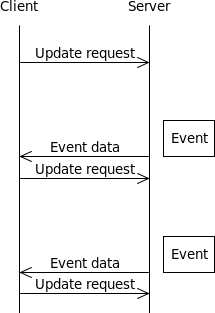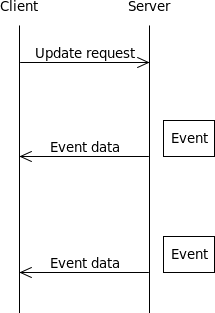Benefits and pitfalls of using HTML5 APIs
Shifts in
the last decade...
From Read-Only to
Read/Write Web
Wikipedia, Youtube, Facebook, Twitter...
From native to
web-based apps
Google Docs, SalesForce, picnik...
From browsers to
app-players
Google V8, Mozilla JägerMonkey, Microsoft Chakra...
From non-standard & proprietary web technologies
(Java, Flash, Silverlight...)
...to fully-featured standards
(HTML5, CSS3, SVG...)
Animations
Declarative & procedural
Declarative animations
CSS & SVG+SMIL
CSS Animations
@keyframes spin {
from { transform: rotate(0deg); }
to { transform: rotate(360deg); }
}
#dot {
animation-name: spin;
animation-iteration-count: infinite;
animation-timing-function: linear;
animation-duration: 2.560s;
}
Libet's clock paradigm on the Web, by Garaizar, P.
SVG + SMIL Animations
<?xml version="1.0" encoding="UTF-8" ?>
<svg xmlns="http://www.w3.org/2000/svg" width="400px" height="100px">
<circle cx="25" cy="50" r="25" fill="blue" stroke="freeze" stroke-width="1">
<animateMotion path="M 25 0 H 350 Z" dur="2s" repeatCount="indefinite"/>
</circle>
</svg>Based on an example @ Mozilla Developer Network.
Procedural animations
Canvas, SVG, WebGL
setTimeout, postMessage, requestAnimationFrame
Procedural animations: Canvas
Box2D JS, by Yasushi, A.
Procedural animations: SVG
iScience Maps, by Reips, U. & Garaizar, P.
Procedural animations: WebGL
JavaScript 2D & 3D particle effects, by Lee-Delisle, S.
Procedural animations: timers
setTimeout
// 60 Frames Per Second
var interval = 1000 / 60;
function start() {
//Define initial status
setTimeout(animate, interval);
}
function animate() {
//Change properties
setTimeout(animate, interval);
}
postMessage
// 60 Frames Per Second
var interval = 1000 / 60;
function start() {
//Define initial status
last = Date.now();
setZeroTimeout(animate);
}
function animate() {
time = Date.now();
if (time >= last + interval) {
//Change properties
last = time;
}
setZeroTimeout(animate);
}
requestAnimationFrame
// 60 Frames Per Second
var interval = 1000 / 60;
function start() {
//Define initial status
last = Date.now();
requestAnimationFrame(animate);
}
function animate(time) {
if (time >= last + interval) {
//Change properties
last = time;
}
User input
collection
DOM events' timestamps
- Specify the time at which the event was created (in milliseconds).
- They may not have millisecond accuracy in some Operating Systems.
Platform-dependent hacks
- Java Applet to expose nanosecond timing function to ECMAScript:
import java.applet.Applet;
public class nano extends Applet {
public long nanoTime() {
return System.nanoTime();
}
}
High-Resolution Timing API
This API provides a monotonically increasing timing function with sub-millisecond resolution not subject to system clock skew or adjustments :
partial interface Performance {
DOMHighResTimeStamp now();
};
Real-Time Communications
HTML5 WebSockets
AJAX
polling

AJAX
long polling

HTML5
WebSockets

WebRTC
- Provides real-time communications between browsers (audio/video conferencing)
- Without requiring proprietary plugins, downloads or installs.
- Relies on two APIs: PeerConnection API and GetUserMedia API.
Conclusions
Conclusions
- Many of these specifications are still under heavy development.
- It is not easy to find living instances of research-related use.
- Our purpose was to provide a roadmap to this new land of opportunity for HTML5.
Thanks for your attention ;-)
Authors
Follow us on Twitter:
References
- T. Berners-Lee, and R. Cailliau, “WorldWide-Web: Proposal for a hypertexts project”. Retrieved from http://www.w3.org/Proposal.html.
- A. McAuley, B. Stewart, G. Siemens and D. Cormie.”The MOOC Model for Digital Practice.” Retrieved from http://davecormier.com/edblog/wp-content/uploads/MOOC_Final.pdf.
- J. Garcia-Zubia, P. Orduña, D. Lopez-de-Ipiña, and G.R. Alves, “Addressing software impact in the design of remote laboratories”. IEEE Transactions on Industrial Electronics, 56, pp: 4757-4767, 2009.
- D. Ragget, “HTML 3.2 Reference Specification, W3C Recommendation”, 14-Jan-1997, Retrieved from http://www.w3.org/TR/REC-html32
- I. Hickson, "HTML5. A vocabulary and associated APIs for HTML and XHTML". W3C Working Draft 20 April 2012. Retrieved from http://www.w3.org/TR/2012/WD-html5-20120320/.
References
- C. Marrin,”WebGL Specification, Version 1.0”, 10 February 2011. Retrieved from https://www.khronos.org/registry/webgl/specs/1.0/
- P. Le Hégaret, R. Whitmer, and L. Wood, “Document Object Model (DOM)”, 2009/01/06. Retrieved from http://www.w3.org/DOM/
- Ecma International, “Standard ECMA-262. ECMAScript Language Specification. Edition 5.1 (June 2011)”. Retrieved from http://www.ecma-international.org/publications/files/ECMA-ST/Ecma-262.pdf
- S. Fraser, D. Jackson, D. Hyatt, C. Marrin, E. O'Connor, D. Schulze, and A. Gregor, “CSS Transforms”, W3C Working Draft 28 February 2012, Retrieved from http://www.w3.org/TR/2012/WD-css3-transforms-20120228/
- D. Jackson, D. Hyatt, C. Marrin, and L.D. Baron, “CSS Transitions Module Level 3”, W3C Working Draft 01 December 2009. Retrieved from http://www.w3.org/TR/2009/WD-css3-transitions-20091201
References
- D. Jackson, D. Hyatt, and C. Marrin, “CSS Animations Module Level 3”, W3C Working Draft 20 March 2009. Retrieved from http://www.w3.org/TR/2009/WD-css3-animations-20090320
- E. Dahlström, P. Dengler, A. Grasso, C. Lilley, C. McCormack, D. Schepers, and J. Watt, “Scalable Vector Graphics (SVG) 1.1 (Second Edition)”, W3C Recommendation 16 August 2011. Retrieved from http://www.w3.org/TR/2011/REC-SVG11-20110816/
- P. Schmitz and A. Cohen, “SMIL Animation”, W3C Recommendation 04-September-2001. Retrieved from http://www.w3.org/TR/2001/REC-smil-animation-20010904/
- A. Deveria, “When can I use... SVG SMIL animation”, Retrieved from http://caniuse.com/#feat=svg-smil
- I. Hickson, “WHATWG HTML Living Standard, Last Updated 13 March 2012, 7.3 Timers”. Retrieved from http://www.whatwg.org/specs/web-apps/current-work/multipage/timers.html#timers
References
- J. Resig, “How JavaScript Timers Work”. Retrieved from http://ejohn.org/blog/how-javascript-timers-work/
- I. Hickson, “WHATWG HTML Living Standard, Last Updated 13 March 2012, 9 Web Workers”. Retrieved from http://www.whatwg.org/specs/web-apps/current-work/multipage/workers.html
- D. Baron, “setTimeout with a shorter delay”, 2010-03-09, Retrieved from http://dbaron.org/log/20100309-faster-timeouts
- J. Mann and J. Weber, “Efficient Script Yielding”, Editor's Draft July 28th, 2011. Retrieved from http://dvcs.w3.org/hg/webperf/raw-file/tip/specs/setImmediate/Overview.html
- J. Robinson and C. McCormack, “Timing control for script-based animations”, W3C Working Draft 21 February 2012. Retrieved from http://www.w3.org/TR/2012/WD-animation-timing-20120221/
References
- A. Deveria, “When can I use... requestAnimationFrame”. Retrieved from http://caniuse.com/#feat=requestanimationframe
- I. Hickson, “HTML Canvas 2D Context”, W3C Working Draft 20 March 2012. Retrieved from http://www.w3.org/TR/2012/WD-2dcontext-20120320/
- A. Munshi and J. Leech,”OpenGL® ES Common Profile Specification Version 2.0.25”, November 2010. Retrieved from http://www.khronos.org/registry/gles/specs/2.0/es_full_spec_2.0.25.pdf
- T. Pixley, “Document Object Model Events”. Retrieved from http://www.w3.org/TR/DOM-Level-2-Events/events.html
- M. Russinovich, “ClockRes v2.0”, Microsoft Technet, 2009. Retrieved from http://technet.microsoft.com/en-us/sysinternals/bb897568.aspx
References
- N. Stewart, “Millisecond accuracy video display using OpenGL under Linux”, Behavior Research Methods, Volume 38, Number 1, 142-145, 2006.
- jsPerf. Retrieved from http://jsPerf.com
- Benchmark.js. Retrieved from http://benchmarkjs.com
- J. Mann, “High Resolution Time”, W3C Working Draft 13 March 2012. Retrieved from http://www.w3.org/TR/2012/WD-hr-time-20120313/
- J. Resig, “Accuracy of JavaScript Time”. Retrieved from http://ejohn.org/blog/accuracy-of-javascript-time/
References
- J. J. Garrett, “Ajax: A New Approach to Web Applications”. Retrieved from http://www.adaptivepath.com/ideas/ajax-new-approach-web-applications
- Comet Daily, “Comet Maturity Guide”, Version: 0.5 (Dec 12, 2009). Retrieved from http://cometdaily.com/maturity.html
- I. Hickson, “The WebSocket API”, Editor's Draft 13 March 2012. Retrieved from http://www.w3.org/TR/websockets/
- P. Lubbers and F. Greco, “HTML5 Web Sockets: A Quantum Leap in Scalability for the Web”. Retrieved from http://websocket.org/quantum.html
- L. Huang, E. Y. Chen, A. Barth, E. Rescorla, and C. Jackson, “Talking to Yourself for Fun and Profit”, in Proceedings of W2SP, 2011.
References
- A. Bergkvist, D.C. Burnett, C. Jennings, and A. Narayanan, “WebRTC 1.0: Real-time Communication Between Browsers”, W3C Editor's Draft 16 March 2012. Retrieved from http://dev.w3.org/2011/webrtc/editor/webrtc.html
- D. Burnett, and A. Narayanan. getusermedia: Getting access to local devices that can generate multimedia streams 22 December 2011. W3C Editors draft (Work in progress.) Retrieved from http://dev.w3.org/2011/webrtc/editor/getusermedia.html
- J. Rosenberg. Interactive Connectivity Establishment (ICE): A Protocol for Network Address Translator (NAT) Traversal for Offer/Answer Protocols. April 2010. Internet RFC 5245. Retrieved from http://tools.ietf.org/html/rfc5245
- J. Rosenberg, R. Mahy, P. Matthews, D. Wing. Session Traversal Utilities for NAT (STUN). October 2008. Internet RFC 5389. Retrieved from http://tools.ietf.org/html/rfc5389
- P. Mahy, P. Matthews, J. Rosenberg. Traversal Using Relays around NAT (TURN): Relay Extensions to Session Traversal Utilities for NAT (STUN). April 2010. Internet RFC 5766. Retrieved from http://tools.ietf.org/html/rfc5766
References
- J. Rosenberg, H. Schulzrinne. An Offer/Answer Model with the Session Description Protocol (SDP). June 2002. Internet RFC 3264. Retrieved from http://tools.ietf.org/html/rfc3264
- H.Alvestrand, and S. Håkansson. Status of W3C WEBRTC. March 2012. IETF 83 Paris - RTCWEB meeting. Retrieved from http://www.ietf.org/proceedings/83/slides/slides-83-rtcweb-7.pdf


